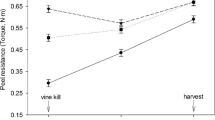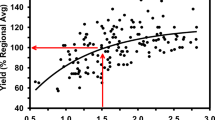Abstract
Worldwide, potato (Solanum tuberosum L.) crops cover 18 × 106 ha, corresponding to a production of 314 × 106 t. The importance of this crop makes it crucial to control production losses and quality defects due to foliar injury, whether by natural or mechanical causes. The artificial defoliation of potatoes is a common technique used to investigate the correlation between damage caused by either hail or insects and yield. The aim of this study was to evaluate simulated hail damage on different cultivar potatoes of varying maturity to quantify the commercial yield reduction attributable to different defoliation levels through the potato crop cycle. Eight trials were carried out in the Central Ebro Valley (northern Spain) over a period of 4 years with three potato cultivars: Jaerla, Red-Pontiac, and Baraka. Four levels of defoliation (no defoliation, slight defoliation, medium defoliation, and high defoliation) were carried out in several phenological stages. The crop yield losses for each level of defoliation were calculated by correlating the percentage of defoliation applied and the resulting percentage of yield loss. Yield reduction equations were calculated for each trial and phenological stage. Damaged produced during tuber formation or flowering considerably reduced yield. In contrast, defoliations after tubers had completed growth barely affected yields. Differences among cultivars with respect to yield losses were noted regardless of location and year. The early cultivar (Jaerla) recovered worse than the longer-cycle varieties (Red Pontiac and Baraka) as concerns defoliation effects. Effects on yield were similar at the different locations. The regression equations presented may be used for modeling the yield reduction due to defoliation treatments caused by different biotic and abiotic agents.
Resumen
En todo el mundo, los cultivos de papa (Solanum tuberosum L.) cubren 18 × 106 ha, lo que corresponde a una producción de 314 × 106 t. La importancia de este cultivo hace crucial el control de las pérdidas de producción y de los defectos en calidad debido al daño foliar, ya fuera por causas naturales o mecánicas. La defoliación artificial de papa es una técnica común usada para investigar la correlación entre el daño causado por granizo o insectos y rendimiento. El propósito de este estudio fue evaluar el daño simulado por granizo en diferentes variedades de papa de diversa madurez, para cuantificar la reducción comercial en rendimiento atribuible a diferentes niveles de defoliación a lo largo del ciclo de cultivo de la papa. Se hicieron ocho ensayos en el valle central del Ebro (al norte de España) en un período de cuatro años con tres variedades de papa: Jaerla, Red-Pontiac, y Baraka. Se efectuaron cuatro niveles de defoliación (sin defoliación, ligera, media, y alta defoliación) en varios estados fenológicos. Se calcularon las pérdidas en el rendimiento del cultivo para cada nivel de defoliación, mediante la correlación del porcentaje de defoliación aplicado y el porcentaje resultante de pérdida en el rendimiento. Las ecuaciones de reducción del rendimiento se calcularon para cada ensayo y estado fenológico. El daño producido durante la formación del tubérculo o en floración redujeron considerablemente los rendimientos. En contraste, las defoliaciones después de que los tubérculos habían completado su crecimiento afectaron los rendimientos muy escasamente. Se notaron diferencias entre las variedades respecto a las pérdidas de rendimiento, independientemente de la localidad y el año. La variedad precoz (Jaerla) fue la peor en recuperarse respecto a las tardías (Red-Pontiac y Baraka) en lo relacionado a las consecuencias por la defoliación. Los efectos en el rendimiento fueron similares en las diferentes localidades. Las ecuaciones de regresión presentadas podrían usarse para modelar la reducción en rendimiento debido a los tratamientos de defoliación causados por diversos agentes bióticos y abióticos.

Similar content being viewed by others
References
Burger, K.H. 1991. Hail insurance for potatoes—no necessity? Kartoffelbau 42: 198–200.
Burger, K.H. 1993. Hail insurance for potatoes. Quantitative and qualitatie aspects. Kartoffelbau 44: 117–119.
Cormack, W.F., D.S. Roger-Lewis, and J.T. Ward. 1992. Tuber yield and size distribution of cv. Estima as affected by physiological age and fertiliser rate. Aspects of Applied Biology. Production and Protection of Potatoes 33: 21–28.
Cranshaw, W.S., and E.B. Radcliffe. 1980. Effect of defoliation on yield of potatoes. Journal of Economic Entomology 73: 131–134.
FAOSTAT. 2010. http://faostat.fao.org/. April 2010.
Feibert, E. S., and M. Saunders. 1993. Simulated hail timing: influence on yield and quality of three potato cultivars. Malheur Country Crop Research Annual Report 100–108.
Ferrandino, F.J. 1998. Estimating crop yield loss in the field caused by plant defoliation. Frontiers of Plant Science 40: 5–6.
Hack, H., H. Gall, T. Klemke, R. Klose, U. Meier, R. Strauss, and A. Witzenberger. 1993. Phänologische Entwicklungsstadien der Kartoffel (Solanum tuberosum L.). Nachrichtenblatt des Deutschen Pflanzenschutzdienstes 45: 11–19.
Jaramillo, J., A.M. Alvarez, and V. Saldarriaga. 1989. Estudios del nivel económico de daño de la polilla de la papa, Phtoriaea operculella (Zeller) (Lepidóptera: Gelechiilae). Revista Colombiana de Entomologia 15: 28–35.
Jewell, S., and R. Stanley. 1989. The influence of defoliation date and harvest interval on the quality of potatoes for french fry production. Potato Research 32: 431–438.
Kalyagin, Y.N. 1985. Recovery of potato plants following frost or hail damage. Ispol’z. mir.kollektsii kul’tur. rast.dlya selektsii 28–31.
Little, T.M. 1981. Interpretation and presentation of results. Hortscience 16: 637–640.
Maillox, G., and N.J. Bostanian. 1989. Effect of manual defoliation on potato yield at maximun abundance of different stages of Colorado Potato Beetle, Leptinotarsa Decemlineata (Say), in the field. Journal of Agricultural Entomology 6: 217–226.
MAPA. 1985. Normas de calidad para la patata de consumo. Madrid: Dirección General de Producción Agraria.
Muro, J., I. Irigoyen, and C. Lamsfus. 1998. Defoliation timing and severity in sugar beet. Agronomy Journal 90: 800–804.
Muro, J., I. Irigoyen, A.F. Militino, and C. Lamsfus. 2001. Defoliation effects on sunflower yield reduction. Agronomy Journal 93: 634–637.
Nault, B.A., P.A. Follet, F. Gould, and G.G. Kennedy. 1995. Assessing compensation for insect damage in mixed plantings of resistant and susceptible potatoes. American Potato Journal 72: 157–176.
Notz, A., and F. Ross. 1994. Simulación de daños de insectos masticadores a diferentes etapas de crecimiento y su efecto sobre el rendimiento de la papa, Solanum tuberosum L. Boletín de Entomología Venezolana 9: 49–54.
Nurmberg, P.L., C.A. Brasil Pereira, E. De Souza Lambert, and C. Beserra De Menezes. 1999. Simulación de daños causados por insectos en la planta de patata por medio de defoliación artificial. Ciência e Agrotecnologia, Lavras 23: 468–472.
Orr, P.H., J.R. Sowokinos, D.C. Nelson, M.C. Thoreson, J.M. Sacks, J.D. Hofer, and K.G. Janardan. 1991. Chipping quality and yield of norchip potatoes damaged by simulated hail. Transactions of the ASAE 34: 2085–2090.
Papadakis, J. 1960. Geografía agrícola mundial. Barcelona: Salvat ed.
Tomlin, E.S., and M.K. Sears. 1992. Effects of Colorado potato beetle and potato leafhopper on amino acid profile of potato foliage. Journal of Chemical Ecology 18: 481–488.
Wille, M.J., and G.E. Kleinkopf. 1992. Effect of simulated hail damage on yield and quality of Russet Burbank potatoes. American Potato Journal 69: 705–714.
Workman, M., and J. Twomey. 1981. The response of Centennial and Russet Burbank cultivars to simulated hail injury. American Potato Journal 58: 524.
Zehnder, G.W., and G.K. Evanylo. 1989. Influence of extent and timing of Colorado potato beetle (Coleoptera: Chrysomelidae) defoliation on potato tuber production in Eastern Virginia. Journal of Economic Entomology 82: 948–953.
Ziems, J.R., B.J. Zechmann, W.W. Hoback, J.C. Wallace, R.A. Madsen, T.E. Hunt, and L.G. Higley. 2006. Yield response of indeterminrate potato (Solanum tuberosum L.) to simulated insect defoliation. Agronomy Journal 98: 1435–1441.
Acknowledgements
The authors thank AGROSEGURO S.A. for funding the trials.
Author information
Authors and Affiliations
Corresponding author
Rights and permissions
About this article
Cite this article
Irigoyen, I., Domeño, I. & Muro, J. Effect of Defoliation by Simulated Hail Damage on Yield of Potato Cultivars with Different Maturity Performed in Spain. Am. J. Pot Res 88, 82–90 (2011). https://doi.org/10.1007/s12230-010-9166-z
Published:
Issue Date:
DOI: https://doi.org/10.1007/s12230-010-9166-z




